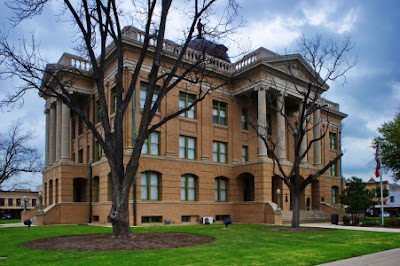. . . . . typical of what we generally think existed in the "Wild West", adjacent to territories not yet States prior to, or through the first decade of, the 20th Century.
To put things into perspective: Texas' independence from Mexico was won in 1836. Admission into the United States as the 28th State came in 1845. Texas seceded from the Union in 1861 less than two months prior to the beginning of the American Civil War (1861-1865), aka the War Between the States, and became part of the Confederacy. Texas was re-admitted to the Union in 1870, during the difficult and lengthy recovery period known as "Reconstruction". 1870 also marks the establishing of The Chisholm Trail, the herding of cattle to market from Texas to Kansas which helped to bolster Texas' floundering post-Civil War economy.
 |
| Parker County Courthouse in Weatherford, Texas Architect: W. C. Dobson Architectural Style: Second (French) Empire Originally completed in 1886 Rededicated in 2002 |
Among Texas' 254 Counties, 242 of its historic County Courthouses are still actively in government use. With their brick and stone towers, ornate cupolas, soaring domes and varying styles of 19th and early 20th Century architecture, they represent an impressive and eclectic collection of public buildings.
The oldest of these Courthouses still in active use is the Cass County Courthouse located in East Texas in Linden, Texas (pop. 1,825), approximately 45 miles southwest of Texarkana, Texas. It is also the only Antebellum courthouse in Texas, its construction having commenced in 1859 prior to the American Civil War, and completed in 1861. By 2022, it had been continuously in use for 161 years.
 |
| Cass County Courthouse in Linden, Texas Builders: L.W. Lissenbee and J.T. Veal Architectural Styles: Greek Revival with Federalist design elements Originally completed in 1861 Rededicated in 2012 |
Because Texas courthouses are among the most widely recognized, used and appreciated assets which are the centerpieces of their communities, the Texas Historical Commission instituted in 1999 what has become its nationally-recognized and award-winning Texas Historic Courthouse Preservation Program (THCPP) which has turned around the trend of disrepair and begun restoring these treasured historic landmarks.
While some of the Courthouses have required structural repair due to damage from weather-related issues such as hurricanes, the most frequent repair work has been to cement or ceramic tile floors, the roofs, often very elaborate masonry, the electrical and plumbing systems, wood furniture, staircases and furnishings, and the installation of central heating/air conditioning. Effort has also been made to restore the original colours and decorative design elements used for both interiors and exteriors. In some instances, there has been removal of additions made during the intervening years which have negated the integrity of the original architectural design. Also, the Courthouses, being governmental buildings used by the public, can require Americans with Disabilities Act (ADA)-compliant retrofitting.
To date, the THCPP has funded 74 Texas County Courthouse restorations. An additional 29 County Courthouses have undertaken emergency or planning work with grant funds. Further, 25 grants have been awarded for the purpose of updating approved preservation Master Plans.
As of the date of publication of his Blog article, 74 Texas County Courthouses of varying architectural styles have been successfully restored and rededicated since 2002 through the Texas Historic Courthouse Preservation Program.
Herein below are photographs of several more of the 74 restored, re-dedicated Texas County Courthouses -- these being originally completed between 1886 and 1932, representing a sampling of the architectural styles popular at the time they were designed and constructed, from Victorian Gothic Revival to Art Deco, and including the architectural provenance of each.
 |
| Potter County Courthouse in Amarillo, Texas Architects: Townes, Lightfoot & Funk Architectural Style: Art Deco Originally completed in 1932 Re-dedicated in 2012 |
 |
| Williamson County Courthouse in Georgetown, Texas Architect: Charles H. Page Architectural Style: Neo-Classical Beaux Arts Originally completed in 1912 Re-dedicated in 2007 |
 |
| Harrison County Courthouse in Marshall, Texas Architect: J. Riely Gordon Architectural Style: Neo-Classical Beaux Arts Originally completed in 1901 Re-dedicated in 2009 |
 |
| Lamar County Courthouse in Paris, Texas Architects: Sanguinet and Staats Architectural Styles: Classical Revival combined with Romanesque design elements Originally completed in 1917 Re-dedicated in 2005 |
 |
| Goliad County Courthouse in Goliad, Texas Architect: Henry E. M. Guidon Architectural Style: Second (Franch) Empire Originally completed in 1894 Rededicated in 2003 |
 |
| Ellis County Courthouse in Waxahachie, Texas Architect: J. Riely Gordon Architectural Style: Romanesque Revival with Italian hand-crafted stone masonry Originally completed in 1897 Re-dedicated in 2002 |
 |
| Denton County Courthouse in Denton, Texas Architect: W. C. Dodson Architectural Style: Blended Romanesque and Second (French) Empire Originally completed in 1896 Re-dedicated in 2004 |
 |
| Bosque County Courthouse in Meridian, Texas Architect: J. J. Kane Architectural style: Victorian Gothic Revival with Italianate design elements Originally completed in 1886 Re-dedicated in 2007 |
(Primary and Photographic Sources: The Texas Historical Commission/Photos by Wayne Wendel; Texarkana Gazette)
